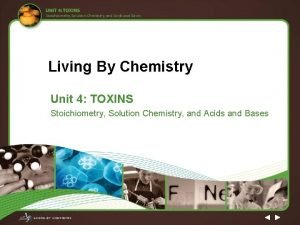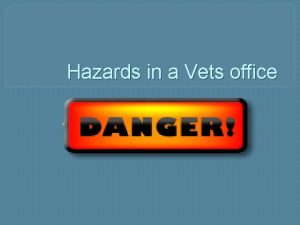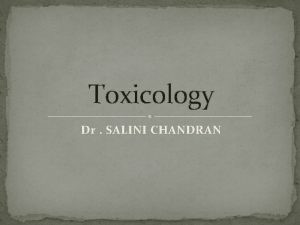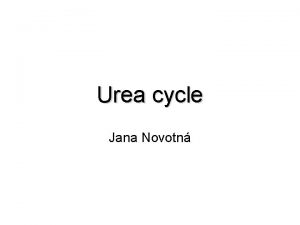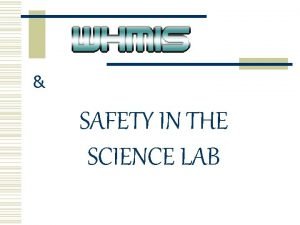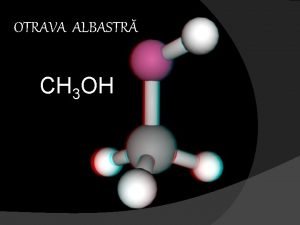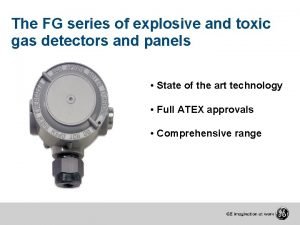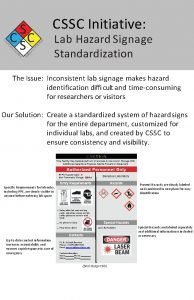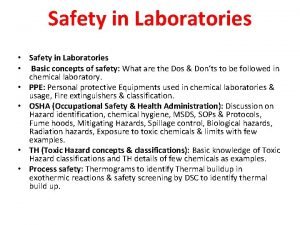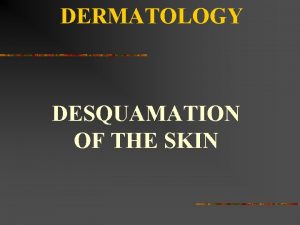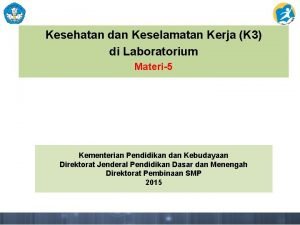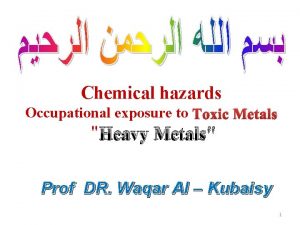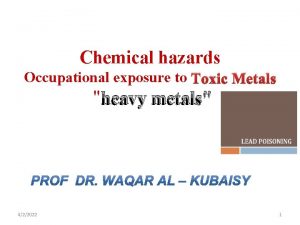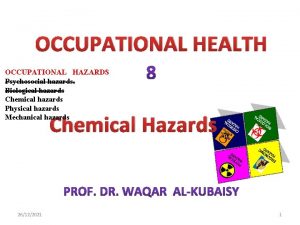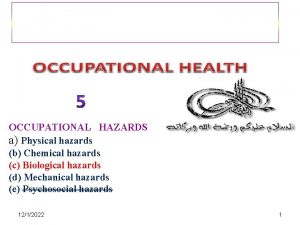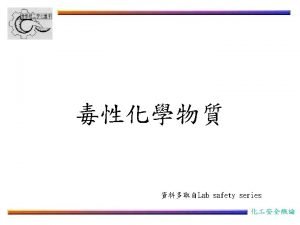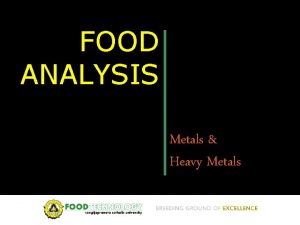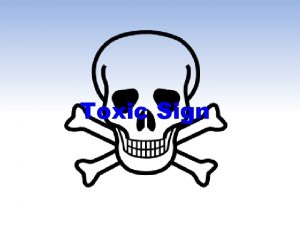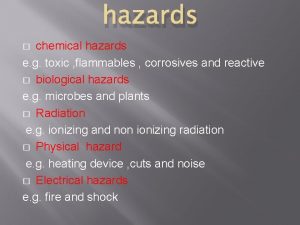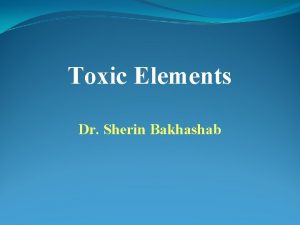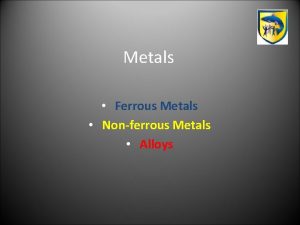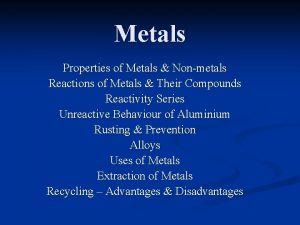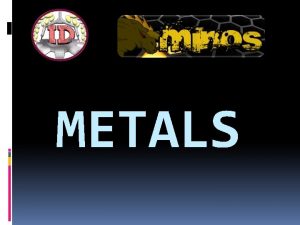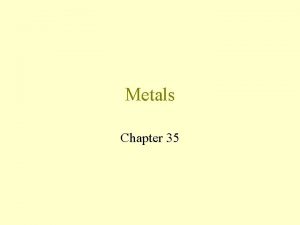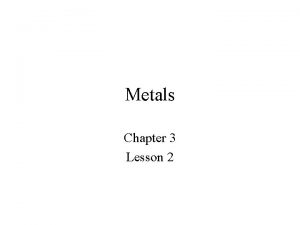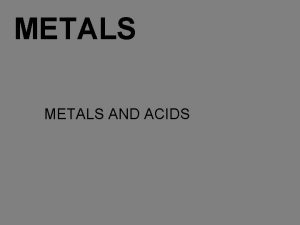Chemical hazards Occupational exposure to Toxic Metals Heavy
































- Slides: 32

Chemical hazards Occupational exposure to Toxic Metals " Heavy Metals" Prof DR. Waqar Al – Kubaisy 1

Mercury Poisoning 18 -3 - 2019 31/12/2021 2

q Mercury is a naturally occurring metal. q in many products everyday, although in tiny amounts q Small amounts of mercury are present in everyday foods and products, which may not harm our health. q It is often a by-product of industrial processes, such as burning coal for power. q Mercury itself is naturally occurring, but the amounts in the environment have been on the rise from industrialization q Too much mercury, however, can be poisonous q Mercury is a type of toxic metal that comes in different forms within the environment q The metal can make its way into soil and water, and eventually to animals like fish 31/12/2021 3

v Mercury is a liquid at room temperature and v readily vaporizes into the air around it. v Vaporized mercury can make its way into the rain, soil, and water, where it poses a risk to plants, animals, and humans. v Consuming foods with mercury is the most common cause of this type of poisoning. v The most common cause of mercury poisoning is from consuming too much methyl mercury or organic mercury, which is linked to eating seafood. v Children and unborn babies are the most vulnerable to the effects of mercury poisoning v Ingesting or coming into contact with too much mercury can cause mercury poisoning 31/12/2021 4

Properties: Mercury and its compounds exist in three general forms: I. Elemental (or metallic). II. Inorganic: Mercury can combine with other elements (mainly chlorine, sulfur, and oxygen) to form inorganic mercury compounds. I. Organic: Mercury may combine with carbon or carbon-containing substances to make organic mercury compounds. • Organic compounds are further divided between alkyl (carbon-chain) • and aryl (aromatic ring) groups. q The difference lies in how it is absorbed, the clinical signs and symptoms, and the response to treatment modalities. v Although all mercury compounds are toxic, the small-chain alkyl compounds are the most hazardous. q Mercury compounds vary in toxicity, so q OSHA provides standards for each. q It is important to clarify which category a compound belongs to • before comparing it with a standard or determining its relative 31/12/2021 5 • toxicity.

Uses and occupations at risk q. Mercury is used mainly for the electrolytic production of chlorine gas and caustic soda ﺍﻟﺼﻮﺩﺍ ﺍﻟﻜﺎﻭﻳﺔ , . batteries , and Also mercury compounds are used in: §pigments; as a catalyst §explosives §pharmaceuticals §chemical applications. q. Mercury is commonly found in thermometers, manometers, barometers, gauges, valves, and high-intensity discharge (HID) lamps. qused in amalgams for dentistry, qpreservatives, heat transfer technology, and lubricating oils. q. The use of mercury compounds as a seed disinfectant, on food crops, q. As a biocide, qin paints and in paint formulations, qas a coating for mirrors, qfor the manufacture of certain types of glass, qas 31/12/2021 a fungicide in paper (has been discontinued or banned). 6

Some examples of WORKERS AT RISK OF being exposed to mercury: Workers in facilities where electrical equipment is manufactured Workers in fluorescent light bulb (CFL) recycling facilities Workers in facilities where automotive parts are manufactured Workers in chemical processing plants that use mercury Workers in medical, dental, or other health services who work with equipment that contains mercury Dentists and their assistants when breathing in mercury vapour released from amalgam fillings 31/12/2021 7

PERMISSIBLE EXPOSURE LIMITS THE CURRENT Occupational Safety and Health Administration (OSHA) standard for organo alkyl mercury compound is 0. 01 mg /cubic meter of air averaged for an 8 hours work shift with a ceiling level of 0. 04 mg/cubic meter of air Mercury poisoning can result from I. vapour inhalation, II. ingestion, III. injection, or IV. absorption through the skin. 31/12/2021 8

• Is there potential for Mercury to build-up or accumulate in the body? • Elemental mercury is a heavy liquid. • • 13. 6 times the weight of water • Occurs naturally in soil and in the atmosphere from volcanic emissions ﺍﻻﻧﺒﻌﺎﺛﺎﺕ ﺍﻟﺒﺮﻛﺎﻧﻴﺔ • • Evaporates at room temperature • The vapor evaporates from the liquid and • evaporation occurs more rapidly when the liquid is heated. I. Inhalation route gives higher exposure q The vapor is well absorbed following inhalation. v it accumulates in the kidney and the brain. q Very toxic to the nervous system, also to kidneys v • But…. very poorly absorbed by the GI tract v Elemental mercury is excreted from the body slowly. v It has an elimination half-life of 40 -60 days. 31/12/2021 Most elemental 9

ont………Is there potential for Mercury to build-up or accumulate in the body • Most elemental mercury is excreted in respired air, • Small amounts in the feces and urine • Very small amounts can be eliminated in sweat, saliva and milk. II. Following ingestion, v elemental mercury is poorly absorbed and v most of it is excreted in the feces. III. through the skin • Elemental mercury liquid and vapor can be • absorbed through the skin in small amounts. 1 V. Elemental mercury is transferred to the developing child in a pregnant women 31/12/2021 10

Health Effects: I. short term exposure • Harmful effects are rarely seen any more because of strict controls used in workplaces where mercury exposure might occur. • Historically, • short-term exposure to high concentrations of mercury vapor caused harmful effects on the Ø nervous, Ø digestive and Ø respiratory systems, and Ø the kidneys. • In most cases, exposure occurred when mercury was heated 31/12/2021 long term 11

Cont. . . Health Effects: II. long term exposure v It is caused by inhalation exposure. v Mercury liquid and vapor are absorbed through the skin in small amounts and this can contribute to the overall exposure. v Effects following absorption through the skin are expected to be similar to those reported for long-term inhalation exposure. q Mercury levels in urine are often used as a general indicator of how much exposure to mercury has occurred. v As a result, urine mercury levels rather than airborne levels are provided in some of the reports which compare mercury exposures to specific health effects. q Urine mercury levels are reported in micrograms/gram of creatinine (a component of the urine). 31/12/2021 The relationship 12

q The relationship between airborne mercury levels and urine mercury levels is complicated and depends on many factors, including other sources of mercury exposure &between individual differences v Several studies indicate that an • airborne exposure of 0. 025 mg/m 3 mercury compares to approximately 37 micrograms of mercury/gram of creatinine in the urine. Urinary mercury levels Level of mercury exposure less than 3 micrograms/gram of creatinine adults without occupational exposure below 35 micrograms/gram of creatinine 35 to 50 micrograms/gram of creatinine low mercury exposure moderate exposure; 50 to 100 micrograms/gram of creatinine moderately high exposure and above 100 micrograms/gram of creatinine high exposure 31/12/2021 13

Cont. . . Health Effects q Initial exposure to high concentrations of mercury vapor produces symptoms similar to "metal fume fever" including fatigue, fever, chills, nausea, headach metallic taste in the mouth. change in blood pressure, and coughing 1) Respiratory system effects include cough, shortness of breath, tightness and burning pains in the chest and inflammation of the lungs. v Occupational exposure to 1 - 44 mg/m 3 of mercury vapor for 4 8 hours caused chest pain, coughing up blood, impaired lung function and inflammation of the lungs. v In some cases, a potentially life-threatening accumulation of fluid in the lungs (pulmonary edema) has occurred. q Exposure to high, but unspecified, concentrations of mercury vapor has caused death due to respiratory failure. v All of the reported deaths resulted from inhaling mercury vapors formed upon heating mercury 31/12/2021 14

Cont. . . Health Effects 2) Harmful nervous system effects: 1. Effects on muscle coordination, 2. mood, behavior, 3. memory, 4. feeling and nerve conduction v These effects are often observed in employees with moderately high or high exposure to mercury. ? ? Ø tremors (initially affecting the hands and sometimes spreading to other parts of the body), Ø emotional instability (including irritability, excessive shyness, a loss of confidence and nervousness), Ø sleeplessness, memory loss, muscle weakness, headaches, slow reflexes and a loss of feeling or numbness. v. Damage to the nerves of the arms and legs (poly-neuropathy) has been reported in employees with high exposures. ? ? ? 31/12/2021 15 Reduced sensation

Cont. . . Health Effects v Reduced sensation and strength in the arms and legs, • muscle cramps and decreased nerve conduction have been observed. v Employees with episodes of very high exposure appear to be more at risk of developing these effects q Pathogeneis of mercury neurotoxicity v • Selectively accumulates in hippocampus, basal ganglia, cerebral cortex v • Prevents presynaptic serotonin release and inhibits serotonin transport; causes calcium disruptions v • Causes demylinating neuropathy q 3) Pregnancy – the risky group first term pregnancies in the mercury exposed group • Spontaneous abortion • Stillbirth • Congenital malformations (spina bifida and intra-atrial defect 31/12/2021 16

Cont. . . Health Effects 4) v • v Ø Kidney injury is common following exposure to high concentrations of mercury. Reported effects range from increased protein in the urine to kidney failure. Exposure to high concentrations of mercury has also caused increased blood pressure and heart rate. 5) Effect when come in contact with skin: • Elemental mercury is not known to directly irritate the skin. • However, an allergic skin reaction may develop following contact with mercury. • Elemental mercury liquid and vapor can be absorbed through • the skin and may contribute to the overall absorption and toxicity 31/12/2021 17

Diagnosing mercury poisoning Ø Physical exam and Ø blood and Ø urine test Few words on investigation v • Blood mercury is only useful within 3 days of exposure and it is more reliable in methylmercury (high concentrations in RBCs) v • A 24 -hour urine specimen is a good indicator for inorganic mercury poisoning v • Hair mercury level has no role in acute Hg toxicity WHO, 2002 31/12/2021 18

Mercury poisoning treatment § There’s no cure for mercury poisoning. • Neurological effects from mercury toxicity are often permanent § When detected early, mercury poisoning can be halted. v The best way is to stop exposure to the metal. § If you eat a lot of mercury-containing seafood, stop immediately. § If toxicity is linked to workplace, need to remove from the area to prevent further effects of poisoning. v If mercury levels reach a certain point start chelation therapy. q In inhalational mercury • No role of inducing emesis • Oral steroid is a common practice but without substantial evidence v • Hemodialysis is used in severe cases of toxicity when renal function has declined Ø Most inhalational form are self limited v If mercury levels reach a certain point start chelation therapy. q Chelating agents are drugs that remove the metal from organs and 31/12/2021 19 help body dispose of them.

Control hazardous conditions • Mercury is a VERY TOXIC liquid. • It is also CORROSIVE to many metals. • It also forms amalgams with some metals, like gold jewelry. q CONTROLLING MERCURY EXPOSURE is best accomplished through v substituting it with a non-toxic chemical, depending on the application. If not: v engineering, v administrative, v personal protective equipment (PPE) v Engineering methods include 1. Mechanical ventilation (dilution and local exhaust), 2. Process or personnel enclosure, control of process conditions, and process modification 3. Stringent ﺻﺎﺭﻡ control measures (closed handling system) or isolation may be necessary. 4. Use a corrosion-resistant local exhaust ventilation system 31/12/2021 20 separate from other exhaust ventilation systems Cleaning of contaminated

Cont. . . Control hazardous conditions 5. Cleaning of contaminated exhaust air before release to the outdoors may be necessary. 6. Supply sufficient replacement air to make up for air removed by exhaust v Personal protective measures include: 1. Approved respiratory protection. Have appropriate equipment available for use in emergencies such as spills or fire. v If respiratory protection is required, 1. institute a complete respiratory protection program including selection, fit testing, training, maintenance and inspection. 2. A face shield may also be necessary to protect eye and face. 3. Chemical protective gloves, coveralls, boots, and/or other chemical protective clothing are required to protect skin. 4. A chemical protective full-body encapsulating suit and respiratory protection may be required in some operations. Remove 31/12/2021 21

Cont. . . Control hazardous conditions 5. Remove contaminated clothing immediately and put in a closed container. 6. Discard or launder before re-wearing. 7. Inform laundry personnel of contaminant's hazards. 8. Do not eat, drink, or smoke in work areas. 9. Wash hands thoroughly after handling this material. 10. Maintain good housekeeping. 31/12/2021 22

Handling recommendations are for the industrial use of mercury. q Before handling, it is important that: Ø Ø Engineering controls are operating and Protective equipment requirements and personal hygiene measures are being followed. People working with this chemical should be properly trained regarding its hazards and its safe use. Maintenance and emergency personnel should be advised of potential hazards. Ø Unprotected persons should avoid all contact with this chemical including contaminated equipment. 31/12/2021 23

Cont. . . Handling recommendations are for the industrial use of mercury • Immediately report leaks, spills or ventilation failures. • Avoid generating vapors or mists. • Prevent release of vapors or mists into the air. • Use the smallest possible amounts in an area separate from the storage area. • When handling large quantities, closed handling systems should be used. • Do not heat mercury in other than a closed system. • Do not use with incompatible materials such as strong oxidizing agents (e. g. chlorine dioxide). Ø Never return contaminated material to its original container. Ø Use the type of container recommended by the manufacturer. • Metals that have good or excellent resistance to corrosion by amalgamation include, iron, steel, stainless steel, and nickel 31/12/2021 Inspect containers 24

Cont. . . Handling recommendations are for the industrial use of mercury Ø Inspect containers for leaks before handling. • Secondary protective containers must be used when this material is being carried. Ø Label containers. Ø Avoid damaging containers. Ø Keep containers tightly closed when not in use. Ø Assume that empty containers contain residues which are hazardous Ø Use corrosion-resistant transfer equipment when dispensing. Ø Whenever possible, use self-closing, portable containers for dispensing small amounts of this material. Ø Never transfer liquid by pressurizing original container with air or inert gas. 31/12/2021 25 Never transfer liquid by

Cont. . . Handling recommendations are for the industrial use of mercury Ø Good housekeeping is very important. Ø Immediate and complete cleanup of spills is necessary. Ø Do not use on porous work surfaces (e. g. wood). Ø Use work surfaces which can be easily decontaminated. v Follow handling precautions on Material Safety Data Sheet. v Have suitable emergency equipment for fires, spills and leaks readily available. • Maintain handling equipment. • Comply with applicable regulations q MERCURY DISPOSAL: Ø • Dispose mercury as a hazardous waste Ø • ‘Never combine it with organic or inorganic waste Ø • Never dispose it in sink/drain Ø • Dispose off in ‘Recycling units 31/12/2021 26

Recommended Medical Surveillance The following medical procedures should be available to each employee who is exposed to organic alkyl mercury at a potentially hazard levels 1 - Initial Medical Examination A complete history and physical examination: the purpose is to detect the preexisting conditions that might place the exposed employee at increased risk and to establish a baseline for future health monitoring. Examination of CNS, Kidney and eye should be stressed, . The skin should be Examine for the evidence of chronic disorders Blood test : Analysis of the blood for mercury may be useful in monitoring absorption 31/12/2021 27

Urinalysis: Since kidney damage has been observed in person exposed to Organic mercury, a Urinalysis should be obtained to include specific gravity, Albumin sugar And microscopic exam 2 - Periodic medical examination : The aforementioned exam should be repeated on an annual basis Reporting signs an d symptoms: The physician should be contacted if anyone developed signs or symptoms and suspects that they are caused by exposure to Organic (alkyl) mercury, 31/12/2021 28

Thank you for attention 31/12/2021 5 th Annual Global Healthcare Conference 29

31/12/2021 30

31/12/2021 31

31/12/2021 32
 Economic exposure refers to
Economic exposure refers to Managing economic exposure and translation exposure
Managing economic exposure and translation exposure Managing economic exposure and translation exposure
Managing economic exposure and translation exposure Operating exposure adalah
Operating exposure adalah Top heavy bottom heavy asymptotes
Top heavy bottom heavy asymptotes Lesson 68 toxic reactions chemical equations
Lesson 68 toxic reactions chemical equations Toxic reactions chemical equations
Toxic reactions chemical equations Reactivity periodic table
Reactivity periodic table Metals vs nonmetals
Metals vs nonmetals Matter and materials grade 7
Matter and materials grade 7 Periodic table with metals and nonmetals
Periodic table with metals and nonmetals Technology grade 7 term 2 notes
Technology grade 7 term 2 notes Examples of alloy metals
Examples of alloy metals Physical hazards in a veterinary clinic
Physical hazards in a veterinary clinic Melting point trend
Melting point trend Cerbera thevetia active principle
Cerbera thevetia active principle Whats bioaccumulation
Whats bioaccumulation Why is ammonia toxic
Why is ammonia toxic Toxic symbol
Toxic symbol Metanolul
Metanolul Fgc toxic
Fgc toxic Health hazard symbol
Health hazard symbol Toxic relatiinship
Toxic relatiinship Toxic multinodular goiter
Toxic multinodular goiter Toxic substances control
Toxic substances control Toxic epidermal necrolysis treatment
Toxic epidermal necrolysis treatment Toxic friendships
Toxic friendships Toxic leadership styles
Toxic leadership styles Schoolofeducators
Schoolofeducators Toxic trio definition
Toxic trio definition Toxic communication
Toxic communication Very toxic
Very toxic Toxic popcorn challenge solution
Toxic popcorn challenge solution






